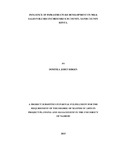| dc.description.abstract | Agriculture, in Kenya, is the backbone of the economy. Its contribution to the Gross
Domestic Product is much higher than other contributors of the economy such as tourism.
According to Muriuki (n.d.) agriculture is subdivided into sub-sections. One of the sections
is livestock production which entails the dairy industry. Unlike in the past, smallholder
production of milk is now becoming commercial or market oriented. As a result of the
changed market orientation of milk, responsible stakeholders have gone ahead to develop
what is called collection centers. Like any other economic activity, dairy farming is
dependent on infrastructure. A geographical study of Chesumei Sub County, Nandi County
reveals that infrastructure is found both in the rural and urban areas. The infrastructure was
affected by rains and bad weather conditions. Therefore, when it is raining they hinder
transportation because of the state they are in. So, the main reason for this research was to
examine the specific influence of infrastructure on milk sales volume by dairy farmers. The
research obtained its data from questionnaires which were administered by the researcher
and interview assisted by a research assistant. Descriptive research design and snowball
techniques were used in the research. The study targeted a population of 1000 who are the
dairy farmers in the area of study and to whom the sample size was chosen from. A simple
random technique was used to choose the subjects participating in the study, by
administering 286 questionnaires. Target population for the study was farmers in Chesumei
Sub County with a target of 1000respoedents. The sampling procedure used was snow
balling arriving at a sample size of 286 respondents. Non probability method was used
during the data collection method. The researcher used questionnaires to collect the data
from the field which had both open ended and closed ended questions. A pilot study was
done to test the validity and reliability of the research instruments. This was done by
obtaining the Cronbachs alpha of the study. Data was analyzed using SPSS to obtain the
descriptive data such as frequencies, and percentages of the respondents. Inferential
statistics was also used to obtain the influence of various variables on sales of milks as per
the conceptual framework. Descriptive analysis allows the researcher to retrieve
percentages and counts participant‘s views on the influence of rural roads access on milk
delivery to collection centers in Chesumei Sub County, Nandi County Kenya. The findings
of the study were presented in table and conclusion was drawn from them. The study
indicated that transportation, telecommunication, energy and water and sanitation did
influence the amount of milk sales during the study and came up with the recommendations
that farmers be sensitized in order to understand the importance of these factors and the
solutions from themselves, County Government and National Government. | en_US |

